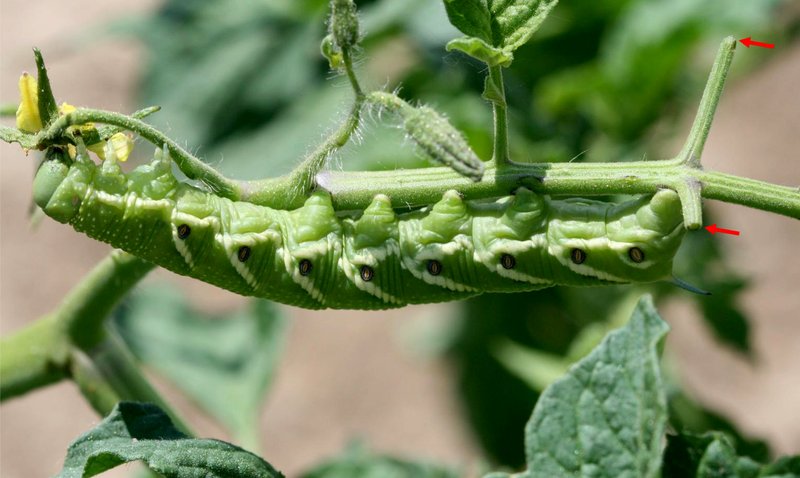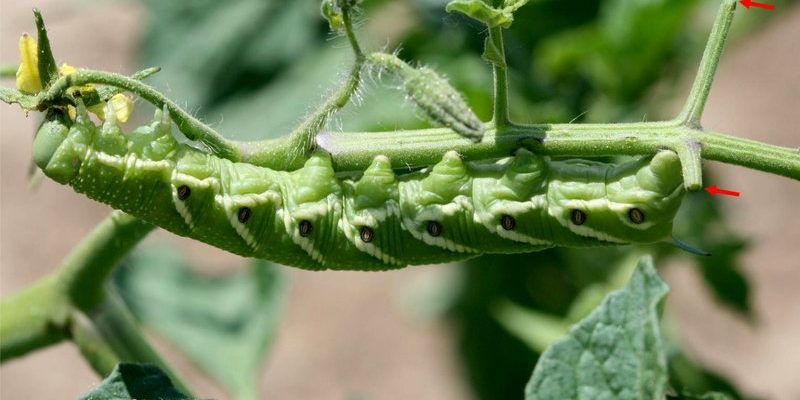
Crop rotation is like changing up your garden’s playlist. Instead of playing the same old tunes (or planting the same crops), you mix things up to keep pests and diseases from getting comfortable. When you plant different crops in the same area over time, it creates a less favorable environment for pests like hornworms. This method doesn’t just benefit your crops; it also enhances soil health and promotes biodiversity.
So, you might be wondering, how does crop rotation actually combat hornworms? Let’s break it down step by step.
What Are Hornworms?
Hornworms are the larvae of moths, specifically the tomato hornworm and the tobacco hornworm. They’re usually a vibrant green color, blending in with tomato plants like a pro. You might spot them when you’re tending to your garden, or perhaps you’ve seen the damage they do: stripped leaves and small, black droppings scattered about.
These caterpillars can grow up to 4 inches long and are notorious for their insatiable appetite. They often appear suddenly and can quickly turn a flourishing garden into a withered mess. Honestly, they’re like that one friend who shows up uninvited and eats all your snacks.
The adult moths lay their eggs on the underside of leaves, and once the eggs hatch, the small caterpillars get to work eating. At this stage, they can be particularly damaging, so spotting them early is key.
Understanding Crop Rotation
Crop rotation involves planting different crops in the same area across seasons or years. It’s an ancient agricultural practice aimed at maintaining soil health and controlling pests and diseases. Imagine your garden as a rotating stage; every year, the performers (crops) change roles, preventing any one group from stealing the show (and nutrients) repeatedly.
The process is pretty straightforward. You follow a sequence of planting crops from different families. For example, if you planted tomatoes one year, you might switch to beans the next. This ensures that the nutrients consumed by one crop can be replenished by the next.
Here’s how crop rotation helps with pests like hornworms:
- Disruption of Life Cycle: By changing the crops, you interrupt hornworms’ life cycle because they generally target specific plants, like tomatoes or peppers. If these plants aren’t there, the hornworms will have a tougher time surviving.
- Soil Health: Rotating crops can improve soil health, leading to stronger plants. Healthy plants can withstand pests and diseases better than weakened ones.
- Diversity: Different plants attract different beneficial insects. These allies can help keep pest populations like hornworms in check.
Benefits of Crop Rotation for Pest Management
Using crop rotation as a pest management technique has several benefits. Here are a few:
1. **Reduced Pest Populations**: By planting different crops, you’re less likely to create a hospitable environment for pests like hornworms. They simply can’t find their preferred food source.
2. **Improved Soil Quality**: Some crops, like legumes, can fix nitrogen in the soil, which benefits subsequent crops. Healthier soil leads to healthier plants that can resist pests better.
3. **Diversity in the Garden**: A mix of plants can attract various beneficial insects, including pollinators and predators of hornworms. This natural control can reduce the need for pesticides.
4. **Balanced Nutrient Demand**: Different plants have varying nutrient needs. By rotating crops, you prevent nutrient depletion in the soil, which can weaken plants and make them more susceptible to pests.
Let’s not forget the importance of planning your rotation carefully. Some gardeners find it helpful to keep a garden journal, noting where and what they plant each season.
Implementing a Crop Rotation Plan
Starting a crop rotation plan may seem daunting, but it doesn’t have to be. Here’s a simple process to get you going:
1. **Know Your Crops**: Identify the types of crops you grow. Group them into families, such as nightshades (tomatoes, peppers), legumes (beans, peas), and brassicas (cabbage, broccoli). This helps in planning rotations.
2. **Create a Schedule**: Decide how long your rotation will be. A common practice is a three- or four-year plan. This ensures each type of crop has enough time to recover before being planted again.
3. **Mix It Up**: Avoid planting the same group of crops in the same spot each year. Instead, rotate them to different areas of your garden. For example, if you planted tomatoes in one section last year, you could plant legumes in that spot this year.
4. **Monitor and Adjust**: Keep an eye on your plants and the pest populations. If certain crops seem especially susceptible to hornworms or other issues, consider adjusting your rotation plan.
Remember, the goal is to create a balance that not only helps control hornworms but also supports overall garden health.
Challenges of Crop Rotation
While crop rotation has many benefits, it also comes with its own set of challenges. Here are a few hurdles you might face:
1. **Limited Space**: If you have a small garden, it may seem tough to implement a full crop rotation. You can still rotate within smaller areas, just be strategic about where you plant your crops.
2. **Knowledge of Crop Families**: Understanding different plant families is essential for effective rotation. If you’re unsure, research or ask at your local garden center for tips on which crops belong to which families.
3. **Weather and Soil Conditions**: Sometimes, the weather can throw a wrench in your plans. If you experience a particularly wet season or drought, you may need to adapt your rotation schedule accordingly to keep your garden thriving.
4. **Time Commitment**: Planning and implementing a crop rotation system requires time. You have to keep track of what you plant each year and possibly adjust your strategy as you learn what works best in your environment.
Despite these challenges, the benefits often outweigh the difficulties. With a little planning and attention, you can create a robust rotation system that protects your garden from hornworms.
Alternatives to Crop Rotation
If crop rotation isn’t feasible for your garden, there are other strategies to consider for managing hornworm populations:
1. **Companion Planting**: Certain plants can repel pests or attract beneficial insects. For instance, planting marigolds near your tomatoes can deter hornworms and other pests.
2. **Physical Barriers**: Use row covers or nets to keep hornworms away from your plants. Just make sure your plants can breathe and get sunlight!
3. **Regular Inspection**: Check your plants regularly for signs of hornworms. Catching them early can prevent them from causing significant damage.
4. **Natural Predators**: Encourage birds and beneficial insects that prey on hornworms. You can attract birds by providing feeders or birdbaths.
Remember that what works best for one gardener might not suit another, so be open to experimenting with various methods until you find the right fit for your garden.
Final Thoughts on Hornworms and Crop Rotation
Managing hornworms can be a challenge for any gardener, but crop rotation is a powerful tool in your pest management toolkit. By changing what you plant and where you plant it, you can disrupt their life cycles and promote healthier plants.
So, whether you’re a seasoned gardener or just starting out, consider how you can integrate crop rotation into your gardening routine. It’s a natural way to protect your plants while also enhancing your garden’s overall health.
In the end, every little effort you make counts. With patience and practice, you can create a garden that not only avoids pest problems but also flourishes year after year. Happy gardening!

